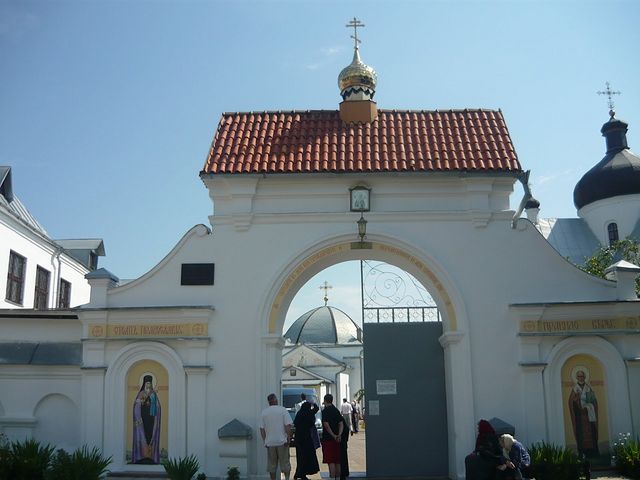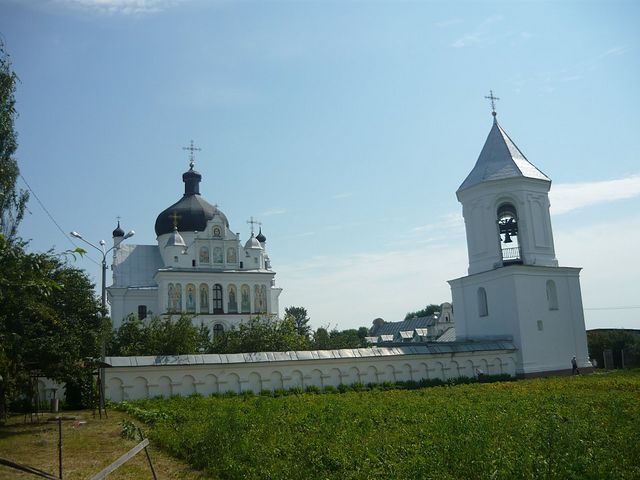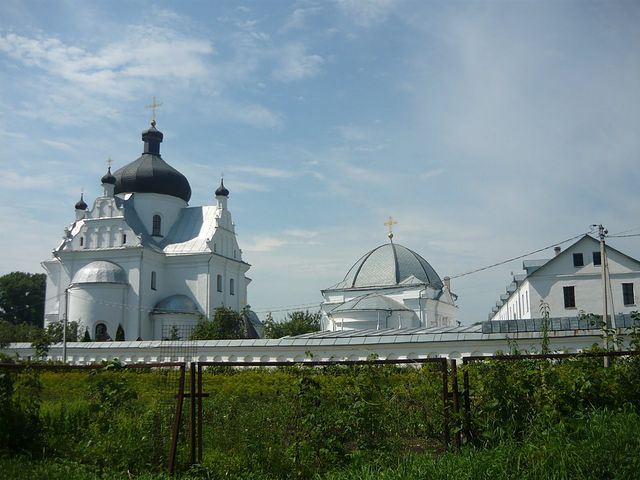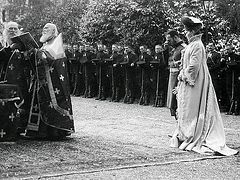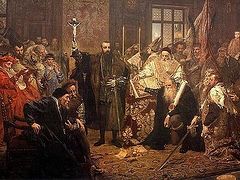The history of the Saint Nicholas Monastery Complex in Mogilev, Belarus1, begins in the 17th century. It was then that the famous Metropolitan of Kiev St. Peter (Mogila)2 managed to obtain the consent of the King of the Polish Lithuanian Commonwealth Władysław IV to build a church in Mogilev in honor of Saint Nicholas.
Concerning Peter Mogila, it’s especially worth speaking. For Western Rus’, which includes both today and historically almost all the canonical territories of the Moscow Patriarchate located west of the current European border of the Russian Federation, Metropolitan Peter Mogila is a very significant and venerated person. And he is honored not only in Western Rus’.
St. Peter had a great influence in the Polish-Lithuanian Commonwealth, especially considering he was from the Mogila family3—the famous rulers of Moldova and Wallachia; St. Peter was the son of Simion Movilă. Having lost power in 1612, the Mogila family found refuge in the Commonwealth; Regina Mohylianka-Wiśniowiecka, niece of Simion Movilă, was married to Michał Wiśniowiecki, a Polish magnate who owned almost the entirety of [what is now modern western and central] Ukraine;4 their son Jeremi Wiśniowiecki was a famous statesmen and military leader in the Commonwealth.
After a short military service,5 St. Peter was tonsured a monk, and in 1627 he became Archimandrite of Kiev Caves Lavra; [which as a Stavropegion] he was directly subordinate to the Patriarch of Constantinople, and not to the Metropolitan of Kiev. Already by 1631, Archimandrite Peter founded a higher theological school in the monastery, in 1632 it combined with the Kievan Epiphany Brotherhood, becoming the famous Kiev-Mogila Collegium, and later Academy [the first Orthodox seminary in the world—Trans.] In fact, it was in this institution where Symeon of Polotsk received his education; Symeon was the adviser to Tsar Alexei Mikhailovich, and teacher of his children he was a man who did much for the establishment of typography, theology, the development of theater, poetic prosody, and other arts in Rus’.
Having strengthened that position, Peter Mogila managed to obtain from Władysław IV and the Polish Sejm the recognition of the rights of the Orthodox Church to exist in the Polish Lithuanian Commonwealth, at least alongside the Uniates.6 He then became Metropolitan of Kiev, Galicia, and all Rus’, and Patriarchal Exarch of the Throne of Constantinople. The Holy Hierarch began to actively work on the restoration and construction of Orthodox Churches, the return of monasteries from Uniatism to Orthodoxy, and the publication of theological literature. It was during this period that St. Peter Mogila sought permission to erect a church in Mogilev.
The influence of Peter Mogila was colossal as a recognized spiritual authority, the most educated person [in Rus’] who was fluent in both Latin and Greek; [his influence] contributed to the strengthening of Orthodoxy in these lands, but after his premature death (he departed to the Lord at the age of 50) in 1647, the interfaith situation in the Commonwealth sharply worsened, leading to the famous uprising of Bogdan Khmelnitsky.
It is no coincidence that the bas-relief of Peter Mogila was placed on the famous monument of The Millennium of Rus’ in Great Novgorod.
Here is what Alexander Vostokov, poet and scholar of the Saint Petersburg Academy of Sciences, had to say about Peter Mogila:
“[Though] a foreigner by birth, but raised by the people and Church to which he gave his whole life, Mogila is more Russian than any Russian.”
In 1996, the Holy Synod of the Ukrainian Orthodox Church canonized Metropolitan Peter (Mogila) as a saint for local veneration, and on December 8, 2005, Saint Peter was established for universal veneration across the entirety of the Moscow Patriarchate. He is still venerated by the people of Romania and Poland.
Now back to the history of the Saint Nicholas Monastery Complex in Mogilev.
In 1637 in Mogilev, with the permission of the Polish King, a temporary wooden church was built under Bishop Sylvester (Kossov).7 A stone church began to be erected in 1669, and in 1672, it was completed and consecrated by Bishop Theodosius (Vasilevich). Soon a women’s monastery was built around the church, but its fate was dramatic.
At the beginning of the 18th century, the monastery was ravaged during the Northern War by the Swedish troops of Charles XII. War and fires dealt the monastery very serious damage, and in 1719, the remaining nuns were transferred to Barkolabovsky monastery, and Saint Nicholas became a men’s monastery, which it remained until 1754. After the abolition of the monastery,8 Saint Nicholas Cathedral acted as a parish church until the 1930s.
In 1793, under the famous Archbishop Georgy Konissky, next to the unheated St. Nicholas Church the construction of a heated winter church began, which was completed in 1798. The Church was then consecrated in honor of Saint Onuphry by Archbishop Anastasius (Bratanovsky-Romanenko).
The Holy Hierarch Georgy Konissky was not only a brilliant preacher, but also politically active, devoting much energy to the defense of Orthodoxy. Attending the coronation of Empress Catherine II, he asked her to protect the Orthodox people of the Polish-Lithuanian Commonwealth from Polish violence and tyranny. Catherine II publicly promised to do this, and she kept her word. St. Georgy also asked the last King of the Commonwealth Stanisław Poniatowski, and in 1767, with the support of the Russian Empress, a formal equalization of the rights of Orthodox with Catholics and uniates was achieved in the Commonwealth. After the reunification of the Belarusian lands with the Russian Empire, at the request of St. Georgy, Catherine II allowed the Uniates to transfer en-masse to Orthodoxy, which over the course of three years, more than 112 parishioners and clergy did.
St. Nicholas Monastery, like the rest of Mogilev, was destined to play a significant role in the life of the last Russian Emperor Nicholas II and his family. As is known, the Headquarters of the Supreme Commander-in-Chief [of Russian forces in WW1] moved to Mogilev on August 8, 1915, and Nicholas II himself arrived here on August 23. And after a few days, the Emperor decided to take command of the army. The Emperor’s headquarters has been in Mogilev for more than two years. Here, his family also lived in a special railway carriage. At that time, famous artists (including Feodor Chaliapin), as well as much of the Russian High Command, including generals such as Mikhail Alekseyev, Anton Denikin, Aleksei Brusilov, Laurus Kornilov, and Admiral Alexander Kolchak, along with many others visited the city for official military, business, and other important matters.
The royal family is well remembered by the residents of Mogilev. The empress and her children often walked around the city and made purchases. Tsarevich Alexei even somehow won a real beehive in the lottery and wanted to take it home, but according to the rules of the lottery, this could not be done before it ended. Then he asked to simply be given the hive for a little bit of time, to show everyone at home.
The royal family often attended divine services, and these services were held in the cathedral of St. Nicholas Monastery. At services along with the royal family, those military men whom we mentioned above also often prayed when they were in Mogilev. Vasily Selim-Giray, the last descendant of the famous Giray dynasty of Crimean khans, also visited the church.
St. Nicholas Cathedral became the church in which future royal martyrs and [loyalist] Russian generals prayed together. Only God knows what they prayed for. But we can assume, remembering what the situation was in the country at that time, that these prayers within the walls of St. Nicholas Cathedral became a kind of farewell to the familiar old-world for the elites of the dying empire, which was crumbling and disappearing before their eyes.
Meanwhile, the situation was approaching its end. On February 23, 1917, Nicholas II arrived from Tsarskoye Selo to Mogilev, but almost immediately he received the news that his children had measles and that unrest had begun in St. Petersburg. As if anticipating the evil, on February 25, the last emperor entered the St. Nicholas Cathedral, to which undoubtedly this record of his diary testifies: “February 25. Saturday. I got up late. The report lasted an hour and a half. At 1 ½ of the road into the monastery I venerated the icon of the Mother of God. I took a walk along the highway to Orsha. At 6 o'clock I went to the all-night vigil. I was engaged there all evening.”
On February 27, the Emperor left for Tsarskoye Selo. The royal train was stopped at the station called Dno. On March 2, 1917, Nicholas II, alone and abandoned by all, signed the manifesto of abdication. Russia suddenly became completely different. It was now not the Emperor, but simply Nikolai Romanov, who, completely defeated, returned on March 3 to Mogilev. He decided to say farewell to the army; [in Mogilev] the Chief-of-Staff, General Alekseev, met him with honors appropriate to the Emperor. On March 4, the Dowager Empress Maria Fyodorovna, mother of the abdicated Emperor, arrived in Mogilev from Kiev. They spent time together until March 8th. On March 8, Nikolai conveyed to the representatives of the Provisional Government his last appeal, but it was never published. In the evening, having said goodbye to his mother, Nikolai, already practically arrested, left for Tsarskoye Selo. Many of the residents of Mogilev came to the station to see him off.
On the night of July 17, 1918, the Tsar and his family were shot in Yekaterinburg. The news pretty quickly reached Mogilev. In St. Nicholas Cathedral a memorial service was served for the slain, to which many citizens came. At the words “For the murdered servants of God Nicholas, Alexandera, Alexy, Olga, Tatiana, Maria and Anastasia” lamentation rang out, and people in the temple knelt down. Mogilev said farewell to the martyrs.
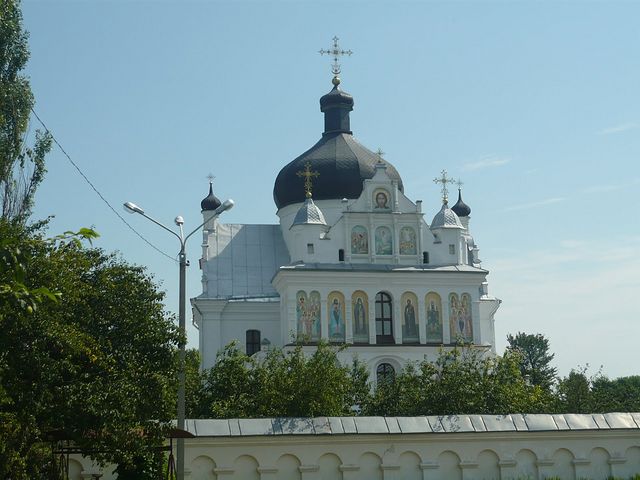 Знаменитые фрески Свято-Никольского собора
Знаменитые фрески Свято-Никольского собора
In the 1930s, the campaign launched by the Bolsheviks against the Orthodox Church also reached the Mogilev Monastery: The church utensils were confiscated, iconostases were destroyed, and the churches themselves ruined. For some time, the life of the parish of St. Nicholas Cathedral was somehow supported by the Priest Mikhail Pleschinsky, but after his death in 1934, the communist authorities closed the cathedral. Three years later, in the wicked year of 1937, the Mogilev diocese was also abolished.
As often happened, the new authorities organized a prison for exiles in St. Nicholas Cathedral in 1937, in which many human lives and destinies were distorted and destroyed. This ended only in 1941, when the Nazis occupied Mogilev.
After the war they did not restore the prison to a church and for ten years, from 1946 to 1956, a bookstore was located in St. Nicholas Cathedral.
Realizing the architectural and historical value of the monastery cathedral, the authorities began to restore it, which continued with varying success for several decades, from 1956 to 1990. This restoration was quite controversial. Many believe that the restoration work, carried out without the participation of Orthodox Church, did not much help to restore the monastery and Cathedral, but actually led to their further decline.
The Mogilev diocese was restored only in 1989. It was headed by the Archbishop of Mogilev and Mstislavl, Maxim (Krokha). It was Archbishop Maxim who made the greatest effort to revive this convent. In 1991, the St. Onuphry Church was consecrated. During construction work on the territory of the monastery, numerous human remains were discovered; most likely these were dead prisoners of the 1930s prison. In the same year, the monastery was visited by His Holiness Patriarch Alexy II, who presented the monastery with a cast chandelier. The main church of the monastery, St. Nicholas Cathedral, is included by UNESCO in the list of the most valuable architectural objects built in the Baroque style.
The first abbess of the revived monastery was Evgenia (Voloshchuk).
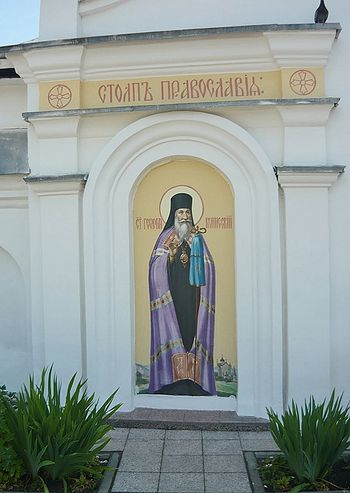 In 1993, by the decision of the Holy Synod of the Belarusian Exarchate of the Russian Orthodox Church, the Holy Hierarch Georgy (Konissky) was numbered among the locally venerated saints.
In 1993, by the decision of the Holy Synod of the Belarusian Exarchate of the Russian Orthodox Church, the Holy Hierarch Georgy (Konissky) was numbered among the locally venerated saints.
The monastery continued to develop. In 1996, a sisterhood was established in the name of the Holy Martyrs Faith, Hope, Love and their mother Sophia. Then they built a two-story residential building for nuns.
The year 2000—the year of the glorification of the Royal Martyrs—was a year in which a significant events in the history of the monastery occurred: A portrait of the martyred Emperor was unexpectedly discovered, which was later consecrated, and is now kept as an icon in the left side-altar of St. Nicholas Cathedral, dedicated to the Holy Royal Martyrs. The attention of many believers was attracted by a coin attached to the icon. According to tradition, the Emperor himself came to the church and gave it as a present to a boy, Semyon Khalimov, when he found out that his father had died in the war. Other relics of the monastery are connected with the name of the last Russian emperor and his family.
There is a copy of the “Three-Handed” icon of the Mother of God, before which the martyrs prayed in the Ipatiev House9; A stone was brought from the Ipatiev house in Yekaterinburg to the monastery, to be laid in a memorial church in honor of the New Martyrs of the twentieth century.
Another holy possession of St. Nicholas Cathedral is the icon of St. Nicholas the Wonderworker with a particle of his relics. The monastery also contains copies of the Belynich Icon of the Mother of God, the Mogilev Brotherhood Icon of the Mother of God, and the Blessed Heaven icon.
Nowadays, an Orthodox youth choir and a Sunday school operate on the monastery grounds, and on August 6, a religious procession takes place from the monastery to the house where St. Georgy (Konissky) lived. A frequent guest in the monastery was the Patriarchal Exarch of All Belarus Metropolitan Philaret.
The monastery became the spiritual center of Mogilev. The efforts of Archbishop Maxim (Krokha) and Abbess Evgenia (Voloshchuk) were not in vain. They themselves have now found rest in the territory of the monastery, buried near St. Nicholas Cathedral.
The 400th anniversary of the Romanov dynasty makes us more attentive to the spiritual and cultural heritage common to Russia and Belarus. I have no doubt that Saint Nicholas Monastery in Mogilev will become one of the popular places of pilgrimage for Orthodox Christians visiting the holy sites of White Russia—Belarus.

